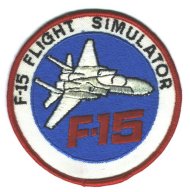About
My name is Gene Buckle and this site covers the process of converting the forward fuselage of F-15C 80-0007 into a fixed-base(no motion system) flight simulator.
The goal is to make the systems simulation as accurate as possible, given the public information available to me. Systems such as the TEWS that are only covered in detail in the “-1-1-1” classified documentation will be implemented based on the SWAG method; Scientific Wild Ass Guesswork. 🙂
The path from this F-15C’s manufacture to my hands is an interesting one.
On September 12th, 1981 ‘007 was being flown at an airshow at Soesterberg AB in The Netherlands. Things…didn’t go as planned.
From the incident report:
On 12 September 1981 at 1459 CET, Eagle 81, a single F-15C, departed Gilze-Rijen AB, NL, enroute to Soesterberg AB, NL for a planned aerial demonstration. At 1518 CET, the pilot of Eagle 81 began his demonstration at Soesterberg from a no flap low approach entry (offset approximately 1500 feet to the left) to runway 31 (the spectators were aligned along the north side of runway 13/31, and all maneuvers were flown in reference to this runway). The demonstration terminated with a pass down runway 31 show line, a pitch up to 25 degrees nose high, followed by a 450 degree roll and turn to downwind for runway 27 (the landing runway). The pilot of Eagle 81 lowered gear and flaps abeam the overrun, and began a left base turn with the speed brake extended. At 1525CET, Eagle 81 crashed 168 feet north, 51 feet past the overrun. The aircraft slid across the overrun and came to rest 183 feet south of the runway after sliding a total distance of 1557 feet. During the slide the aircraft rotated in a clockwise direction, and came to rest on a heading of 061 degrees. The pilot was uninjured and completed a ground egress. RNLAF fire personnel responded immediately and extinguished a fire in the number one fuel tank area.
‘007 is a Block 25 F-15C and was delivered to the USAF on July 8th, 1981. At the time of the accident, ‘007 had a mere 9.5 total flight hours. Because of the extensive damage, the airframe was written off as “destroyed/beyond economic repair” (“BER” basically means that the cost to repair the aircraft exceeds its replacement cost.)
At some point after the accident, the cockpit section was completely stripped of avionics, ejection seat (and rails!), and side console panels. The wiring harnesses for those systems were left in place.
The cockpit section was then transferred Boeing for their use at Brooks AFB as a lab rat in the TLSS (Tactical Life Support System) program that was run by Boeing. I suspect that the side console blank covers and the instrument panel cover was installed at this time. New (simple c-channel) ejection seat rails were also installed.
After its time with Boeing, it was disposed of as surplus in the early-90s. I suspect that had ‘007 still been in the possession of the USAF, it would have been ground up as scrap.
In 2000, I discovered ‘007 sitting outside the Olympic Flight Museum, located at the Olympia Regional Airport in Olympia, WA. As it turned out, the cockpit section was on loan to the museum for a recently cancelled project. I was able to reach the owner and I purchased ‘007 for $1500.
80-0007 is currently the only F-15C (part or whole) in civilian hands, anywhere in the world. The project is very slow going, but it IS still going.



